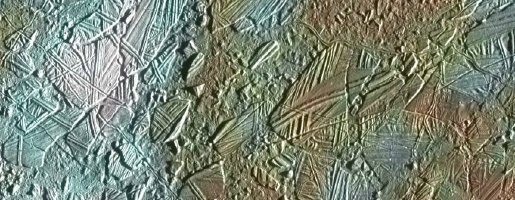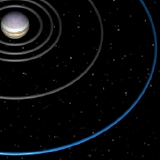 |
|
|
Enhanced
Galileo image of ice rafts on Europa's surface.
|
|
| EUROPA - MOON OF JUPITER | |
| Europa was discovered by Galileo Galilei in 1610, at the same time as he discovered Io, Ganymede and Callisto. These four moons are therefore known as the Galilean satellites. Europa is very reflective, and as its size is comparable to our Moon, it is visible from Earth using small instruments like binoculars. | |
| In Greek mythology, Europa was kidnapped by Zeus, and was the mother of Minos. | |
| Orbit | |
 Europa's orbit. |
|
| Europa orbits Jupiter at an average distance of 670,000 kilometres, placing it well within Jupiter's magnetosphere. Europa's close orbit to Jupiter means the moon may suffer internal heating due to Jupiter's powerful gravitational field. | |
 Europa, left, and Io, right, as seen by Voyager 1. |
|
| Nearly as big as our Moon | |
| Europa is the fourth largest of Jupiter's moons and the smallest of the Galilean satellites - Io, Ganymede and Callisto are all larger. Nevertheless, it still has a size 90% that of our own Moon. | |
| Life on Europa? | |
| Recent discoveries concerning the interior of Europa have made this moon one of the most fascinating objects in the Solar System. There is a possibility that Europa's surface hides an ocean of liquid water - if so, can it support life? | |
| More about Europa's evolution and interior | |
| Magnetism detected by probe | |
| A weak magnetic field was detected by the Galileo spacecraft. It is unknown whether this is caused by a metal-rich core, or whether the magnetic field is induced in Europa by Jupiter's magnetic field. | |
| Oxygen in the atmosphere | |
| The Hubble Space Telescope has discovered that Europa has an extremely thin atmosphere of oxygen. The pressure of this atmosphere is about 100 thousand millionth that of Earth's atmosphere. The most likely source of the oxygen is decomposition of water molecules knocked from Europa's icy surface. Europa's surface is constantly bombarded by dust, and by charged particles trapped in Jupiter's powerful magnetic field. The Galileo spacecraft has also detected hydrogen peroxide - a chemical used to turn brown hair to blonde. Hydrogen peroxide does not occur naturally on Earth, and has to be manufactured. On Europa, the chemical is a result of Europa's surface being constantly bombarded by Jupiter's intense particle radiation. The hydrogen peroxide does not live long, eventually being broken down into hydrogen and oxygen. | |
| Temperatures | |
| This image, acquired by the Galileo spacecraft, shows temperatures across the full disk of Europa. Midday equatorial temperatures on Europa climb to -143oC (130K), with polar regions being colder. The small variations in temperature are caused by the different properties of the surface - darker areas absorb more sunlight and are therefore slightly warmer. | |
 Europa's daytime temperatures. |
|
| Smooth Surface | |
| The Europan surface, one of the smoothest in the Solar System, is covered with ice. Europa is so smooth it has often been compared to a billiard ball. As well as being deficient in craters, the surface is fractured and deformed. Somehow Europa is being resurfaced. There may also be active volcanism, with geysers still active today. | |
| More about Europa's surface | |
| The Galileo mission | |
| Although Europa was discovered in 1610, most of our knowledge of Europa has come from the recent Galileo mission and Voyager missions. As Europa may have a liquid ocean, it has become a high priority target for future exploration. | |
|
|
|